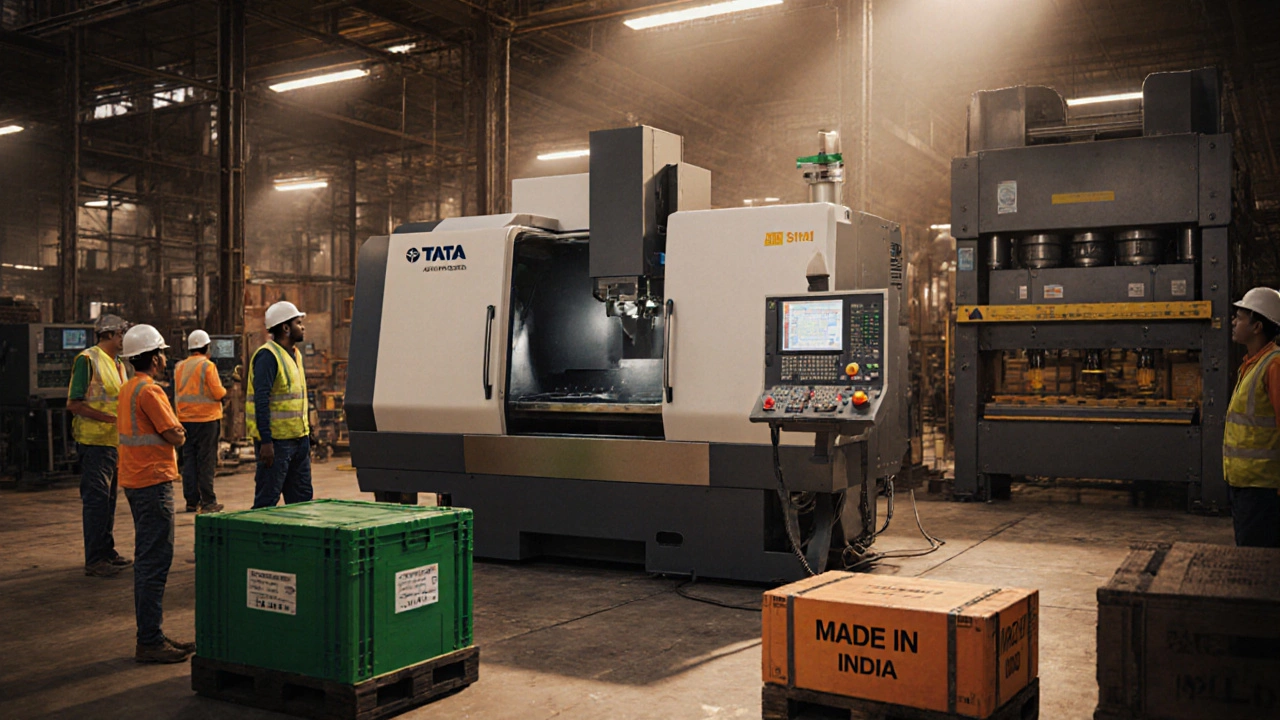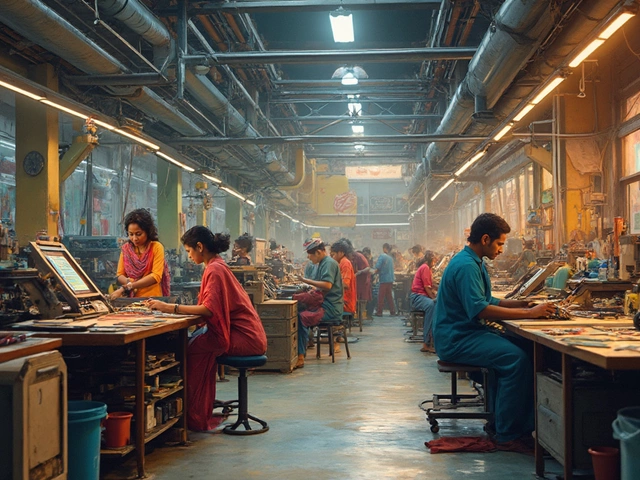Machinery Source Selector
Find the Best Country for Your Machinery Needs
Answer a few questions to discover which country's machinery best fits your requirements.
Best Country Match
When you think of heavy machinery, you don’t just picture cranes or tractors-you think of precision, durability, and decades of engineering mastery. But which country actually makes the best machinery today? It’s not a single answer. Some nations lead in high-tech CNC machines, others dominate in agricultural equipment, and a few are rising fast with cost-effective, reliable output. If you’re sourcing for a factory, upgrading your workshop, or just curious about global industrial powerhouses, here’s what actually matters in 2025.
Germany Still Leads in Precision Machinery
Germany isn’t just good at machinery-it’s the gold standard. Companies like Siemens, Trumpf, and DMG MORI produce machine tools that are used in aerospace, automotive, and medical device factories worldwide. Their CNC lathes and milling centers don’t just work-they hold tolerances within microns, run for years without calibration drift, and integrate seamlessly with Industry 4.0 systems.
Why does Germany dominate? It’s not luck. The country has a 200-year legacy of mechanical engineering education, mandatory apprenticeships, and strict quality controls. A German-made machining center might cost 40% more than a Chinese alternative, but it lasts twice as long and requires less downtime. Factories in Japan, the U.S., and even India often choose German machines because they can’t afford the hidden costs of failure.
Japan: The Quiet Master of Automation
If Germany builds the tools, Japan builds the systems that run them. Companies like FANUC, Mitsubishi Electric, and Kawasaki Robotics dominate industrial automation. Their robots don’t just move parts-they learn, adapt, and self-diagnose. A FANUC robot on a Toyota assembly line can adjust its torque based on real-time sensor feedback, reducing scrap rates by up to 18%.
Japan’s edge isn’t just in robotics. Their machine tool builders focus on reliability over flash. A Japanese lathe might not have the most flashy touchscreen, but it’ll run 24/7 for a decade with minimal maintenance. This makes them ideal for high-volume production environments where uptime equals profit.
China: Volume, Speed, and Rising Quality
China produces more machinery by volume than any other country. Brands like Suzhou Huaqiang, Shanghai Machine Tool Works, and Yaskawa China churn out thousands of CNC machines, injection molding units, and packaging lines every year. Prices are often 50-70% lower than German or Japanese equivalents.
But here’s the shift: in 2025, Chinese machinery isn’t just cheap-it’s becoming competitive. Companies like Haas Automation China and CRRC now export machines with CE and ISO certifications that meet European and U.S. standards. The catch? You need to vet suppliers carefully. Some still cut corners on bearings, cooling systems, or software stability. But the best Chinese manufacturers now offer warranties, remote diagnostics, and local service centers in Europe and North America.

India: The Fastest-Growing Machinery Hub
India isn’t just a market-it’s becoming a maker. Companies like Tata Advanced Systems, L&T Machine Tools, and Godrej & Boyce are building everything from agricultural tractors to heavy-duty presses. India’s advantage? Low labor costs, a growing engineering talent pool, and government push through schemes like Make in India and Production Linked Incentive (PLI) programs.
Indian machinery used to be seen as budget-friendly but unreliable. That’s changing fast. Tata’s CNC machines now feature real-time IoT monitoring and are exported to Southeast Asia and Africa. L&T’s hydraulic presses are used in defense manufacturing across three continents. India’s strength? Customization. Need a 10-ton press that runs on 220V single-phase power? Indian manufacturers can build it. German firms usually can’t-they’re locked into standardized, high-end European specs.
United States: Niche Innovation and Defense Tech
The U.S. doesn’t lead in volume, but it leads in high-end niches. Companies like Haas Automation, Doosan Machine Tools (U.S.-based), and Okuma America produce machines used in defense, space, and medical device production. The U.S. also dominates in additive manufacturing-3D printers that build turbine blades or titanium implants with micron-level accuracy.
U.S. machinery often combines German precision with American software. Think of a Haas CNC machine running on a custom-built AI toolpath optimizer. These aren’t for small workshops-they’re for companies that need zero tolerance on critical parts. The downside? Prices start at $150,000 and climb from there.
Comparison: Where Each Country Excels
| Country | Best For | Typical Price Range | Key Strength | Best For |
|---|---|---|---|---|
| Germany | High-precision CNC, laser cutters | $100,000-$500,000+ | Accuracy, longevity, integration | Medical, aerospace, R&D |
| Japan | Industrial robots, automated lines | $80,000-$400,000 | Reliability, low maintenance | High-volume production |
| China | General-purpose CNC, packaging | $20,000-$150,000 | Cost, speed, scalability | Small factories, export markets |
| India | Agricultural, heavy presses, custom builds | $15,000-$120,000 | Customization, local support | Emerging markets, tier-2 industries |
| United States | Defense tech, 3D printing, aerospace | $150,000-$1M+ | Innovation, software integration | Specialized, high-value sectors |

What ‘Best’ Really Means for You
There’s no single ‘best’ country for machinery-it depends on what you need.
If you run a small auto repair shop and need a reliable brake lathe, a Chinese machine under $30,000 with a 2-year warranty might be perfect. If you’re making turbine blades for a jet engine, you’ll pay $400,000 for a German machine that’s been tested to 10 million cycles. If you’re setting up a factory in Nigeria and need a custom grain crusher that runs on diesel, India’s your best bet.
The biggest mistake? Choosing based on price alone. A $10,000 machine that breaks down every three months costs more than a $50,000 one that runs for 10 years. Look at total cost of ownership: maintenance, downtime, spare parts availability, and training.
India’s Rise in Machinery Manufacturing
India’s machinery sector grew 14% in 2024 alone, according to the Indian Machine Tool Manufacturers’ Association. That’s faster than China’s 7% and Germany’s 3%. Why? Three things:
- Local demand: India’s infrastructure push needs cranes, concrete mixers, and mining equipment-so companies are building them.
- Export growth: Indian machinery exports hit $12 billion in 2024, up from $6 billion in 2020. Africa, Southeast Asia, and Latin America are buying.
- Skilled workforce: India graduates 1.5 million engineers a year. Many now work in machine design, not just software.
Companies like Amara Raja and Varroc are now supplying machinery to global brands like Bosch and Siemens. It’s not just about making cheap stuff anymore-it’s about making the right stuff, at the right price, for the right markets.
Final Thoughts: No One Country Wins
The ‘best’ machinery country isn’t the one with the fanciest ads. It’s the one that matches your needs. Germany for precision. Japan for reliability. China for volume. India for customization. The U.S. for cutting-edge niches.
For most small and medium businesses, the smart move isn’t chasing the ‘best’-it’s finding the right balance. Test a Chinese machine for non-critical tasks. Buy a German spindle for your main CNC. Use Indian-made presses for heavy forming. Mix and match. That’s how modern manufacturing works in 2025.
Don’t buy based on reputation. Buy based on results. Ask for real-world performance data. Talk to other users. Visit factories if you can. The machines don’t lie.
Is India a good source for machinery manufacturing?
Yes, especially for custom, heavy-duty, or cost-sensitive equipment. Indian manufacturers now produce reliable agricultural machinery, hydraulic presses, and CNC systems that meet international standards. Many export to Africa, Southeast Asia, and the Middle East. For non-critical applications, India offers strong value.
Why is German machinery more expensive?
German machinery costs more because it’s built for extreme precision, longevity, and integration with automated systems. It uses high-grade materials, undergoes rigorous testing, and comes with long-term service support. A German CNC machine might cost 3x more than a Chinese one, but it can last 15-20 years with minimal downtime.
Can I trust Chinese machinery for industrial use?
Yes-if you choose reputable brands and verify certifications. Top Chinese manufacturers now offer CE, ISO, and even UL certifications. Look for companies with local service centers, warranty support, and customer reviews. Avoid unknown brands selling at prices that seem too good to be true.
What machinery is India best at making?
India excels in agricultural machinery, heavy hydraulic presses, mining equipment, and custom-built industrial tools. Companies like L&T and Tata make machines that handle harsh conditions and variable power supplies-ideal for developing markets. They also produce CNC systems for mid-range applications at competitive prices.
Should I buy machinery from Japan?
If you need automated production lines or robots that run 24/7 with near-zero failure, Japan is the top choice. FANUC and Mitsubishi machines are the backbone of global manufacturing. They’re not cheap, but they reduce labor costs and scrap rates over time. Best for high-volume, high-precision environments.






